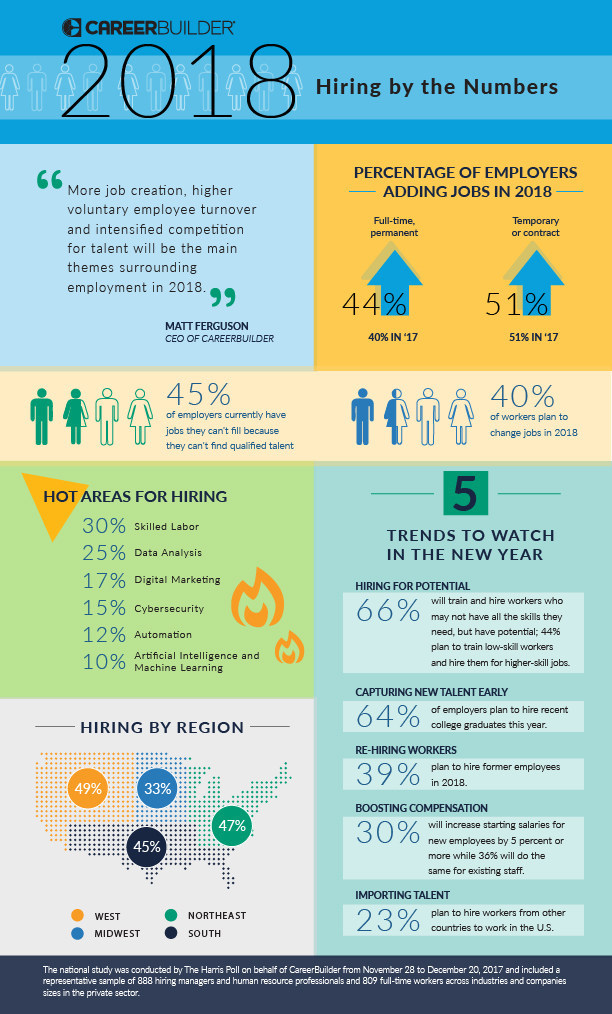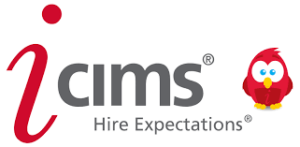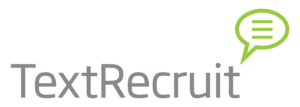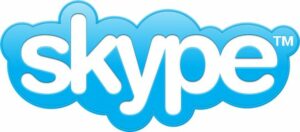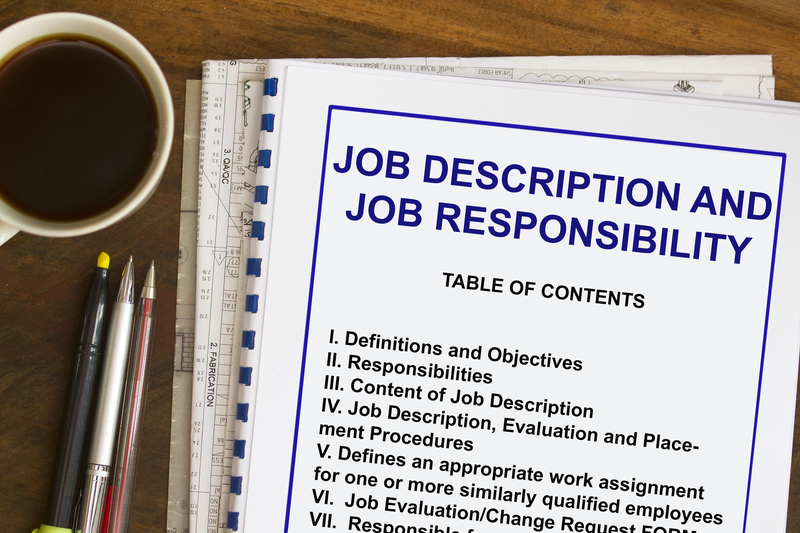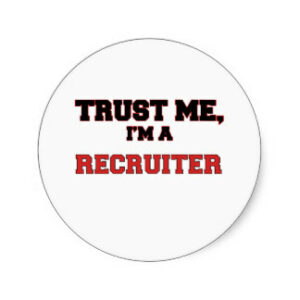 A New Year brings new recruitment and employment surveys, and the first one of the year brings information that you probably won’t be all that surprised by.
A New Year brings new recruitment and employment surveys, and the first one of the year brings information that you probably won’t be all that surprised by.
According to CareerBuilder’s annual forecast, 44 percent of employers say they plan to hire permanent full-time employees this year. In addition, 51 percent of are planning to hire temp workers in 2018.
But here’s the catch — 45 percent of HR managers say they have jobs open that they can’t fill because, as the CareerBuilder survey notes, “they can’t find qualified talent.” And, 58 percent of these HR leaders say they have jobs that stay open for 12 weeks or more.
“A perfect storm … in the U.S. labor market”
If that wasn’t enough, add this into the mix as well: the CareerBuilder survey also found that 40 percent of workers say they plan to change jobs in the New Year, and the combination of all of this makes for a tough recruiting challenge as we try to kick start 2018.
“More job creation, higher voluntary employee turnover and intensified competition for talent will be the main themes surrounding employment in 2018,” said Matt Ferguson, CEO of CareerBuilder, in a press release about the survey.
And, he also had this ominous analysis:
There is a perfect storm happening in the U.S. labor market. Low unemployment paired with lagging labor force participation and a growing skills gap is making it very difficult for businesses to find qualified candidates – and this is for all types of roles. If employers want to remain competitive, they are going to have to look to new talent pools and significantly increase their investment in training workers to build up the skills they require.”
Overall, the CareerBuilder survey noted that the amount of employers planning to hire full-time, permanent staff in the New Year was pretty similar to last year (40 percent in 2017 to 44 percent in 2018), while 6 percent of employers expect a decline in staff levels in 2018, an improvement from 8 percent last year. Close to half of employers surveyed (45 percent) anticipated no change this year, while 5 percent were unsure.
5 employer trends to watch for this year
Besides the top line poll numbers, the CareerBuilder survey also broke out the five (5) biggest employer trends to watch for in the New Year. They are interesting and also give some insight into the kinds of strategies many organizations are looking at as they deal with finding talent in a hard-to-find-talent market.
- Capturing new talent early – From CareerBuilder: “Employers will start courting college students early – 64 percent plan to hire recent college graduates this year.” My take: If American employers are REALLY serious about finding the best and the brightest college students, they will increase paid internships and maybe even bring back some of the structured post-college training programs that were popular back in the 1970s and 80s to increase the pipelines they have to attract young talent.
- Importing talent – From CareerBuilder: “Employers will be looking beyond borders to find talent with 23 percent planning to hire workers from other countries to work in the U.S.” My take: Employers may plan to hire workers from other countries, but President Trump’s push to cut back on visas for foreign workers may hamper their attempts to do so.
- Re-engaging past employees – From CareerBuilder: Employers will increase outreach to workers who know their business and have a history with them – 39 percent plan to hire former employees in 2018. My take: Hiring “boomerang” employees makes good sense, but there are always complications hiring workers who previously left your employ since most of them had a reason for leaving that may still need to be resolved. I think it’s a pipe dream to assume there will be a big increase in hiring these kinds of people.
- Hiring for potential – From CareerBuilder: “66 percent of employers said they will train and hire workers who may not have all the skills they need, but have potential; 44 percent of all employers plan to train low-skill workers who don’t have experience in their field and hire them for higher-skill jobs.” My take: This is a trend I can really get behind, because if it really takes hold it will help break this terrible cycle we’re in where recruiters seems to want ready-made employees with all the skills and experience needed. The question is will companies REALLY invest in doing this?
- Boosting compensation – From Career Builder: “While wage gains have not reached desired levels, employers will become more aggressive with compensation levels for in-demand workers — 30 percent plan to increase starting salaries for new employees by 5 percent or more while 36 percent will do the same for existing staff.” My take: This has been the big mystery as employers cry about talent shortages. Why won’t they simply raise wages to attract better people and help hold on to the ones they have? They have stubbornly resisted doing this despite their cries about a tight labor market. Yes, increasing pay REALLY needs to happen, but I’d file it in the category of “I’ll believe it when I see it.”
My 3 takeaways from the CareerBuilder survey
Here’s my take: There is nothing terribly surprising about the numbers in this CareerBuilder survey except that they look a lot like the numbers from last year. The commentary about what employers “plan” to do sounds familiar as well.
What the findings from the CareerBuilder survey say to me is that the employers’ “plan” for 2017 wasn’t executed very well, so they simply tweaked it and rolled out one that looks and feels the same for 2018.
Isn’t the definition of insanity “doing the same thing over and over and expecting a different result?”
My view is that employers need to do three (3) things differently this year if they really want to build their talent and better compete in our hyper-competitive economy:
- Pay more and pay better — Increase pay levels to help keep the staff you already have (yes, improve retention), as well as pay more to better compete for the talent you say you can’t find and hire. By the way, this happened during the dotcom boom, and that was the last real period of robust employment the U.S. has had. We could learn a thing or two from that.
- Train, train, and train some more — A made a prediction last month that companies would finally start spending more on training, and although I think they will, I fear it won’t be enough. Expecting workers to come fully ready to just step in and work isn’t feasible, and the colleges have never really done this well. Whatever you’re spending on training should probably be increased by 50 percent or more so that you can re-train your current staff as well as train up our new hires. I guarantee that if you do it right, it will be money well spent.
- Fix your recruiting function to better evaluate candidates you haven’t been properly considering — Count me as one of those who believe that this notion that we have a huge talent shortage is mostly BS. Yes, there are talent shortages in certain specific areas, but there are also a lot of people — older, or those who don’t match up perfectly, or have the exact kind of experience, or have some other issue in their background — who are looking for solid work and frustrated that they can’t seem to get serious consideration. Your recruiting function needs to change to better consider these people, because there are a lot of them out there (like me) who have the talents and skills to do all sorts of things if they just get a decent chance.
Yes, that’s all that I took away from this CareerBuilder survey. How about you?
The national study was conducted by The Harris Poll on behalf of CareerBuilder from Nov. 28 to Dec. 20, 2017 and included a representative sample of 888 hiring managers and human resource professionals and 809 full-time workers across industries and companies sizes in the private sector.


